DRESSMAKING QUARTER 3 Content Standard: The learner demonstrates understanding in the use of sewing tools in dressmaking. Most Essential Learning Competency: Identify Sewing Tools and Equipment NAME:_____________________________________________ DATE:________________________ GRADE & SECTION:___________________________________ SCORE:______________________ Time Started Reading:_______________________ Time Ended Reading:______________________ Direction: Read the selection very well and answer the following questions. Sewing Tools and Equipment Success in sewing calls for the right tools at the right time. All tools must be appropriate in a proper order and one must know how to use them to save time and produce the best result. A. MEASURING TOOLS Tape Measure A flexible measuring device used in taking body measurements. The front has the measurement of 150 centimeters and 60 inches on the other side. Sewing Gauge A small ruler with a sliding guide and is about six inches long. This gauge is used for measurements at hem lines, button holes and areas where other small measurements require checking, such as pleats and tucks. Rulers A ruler measuring 12 inches or even 18 inches, either clear or solid. It is a useful tool to have for measuring and drawing straight seam lines and cutting lines. It also aids in connecting lines. Nat’l Highway, Alicia, Isabela, 3306 ☎ 0917-6342778 https://www.facebook.com/alicianational.highscho/ ✉ 300500alicianhs@gmail.com
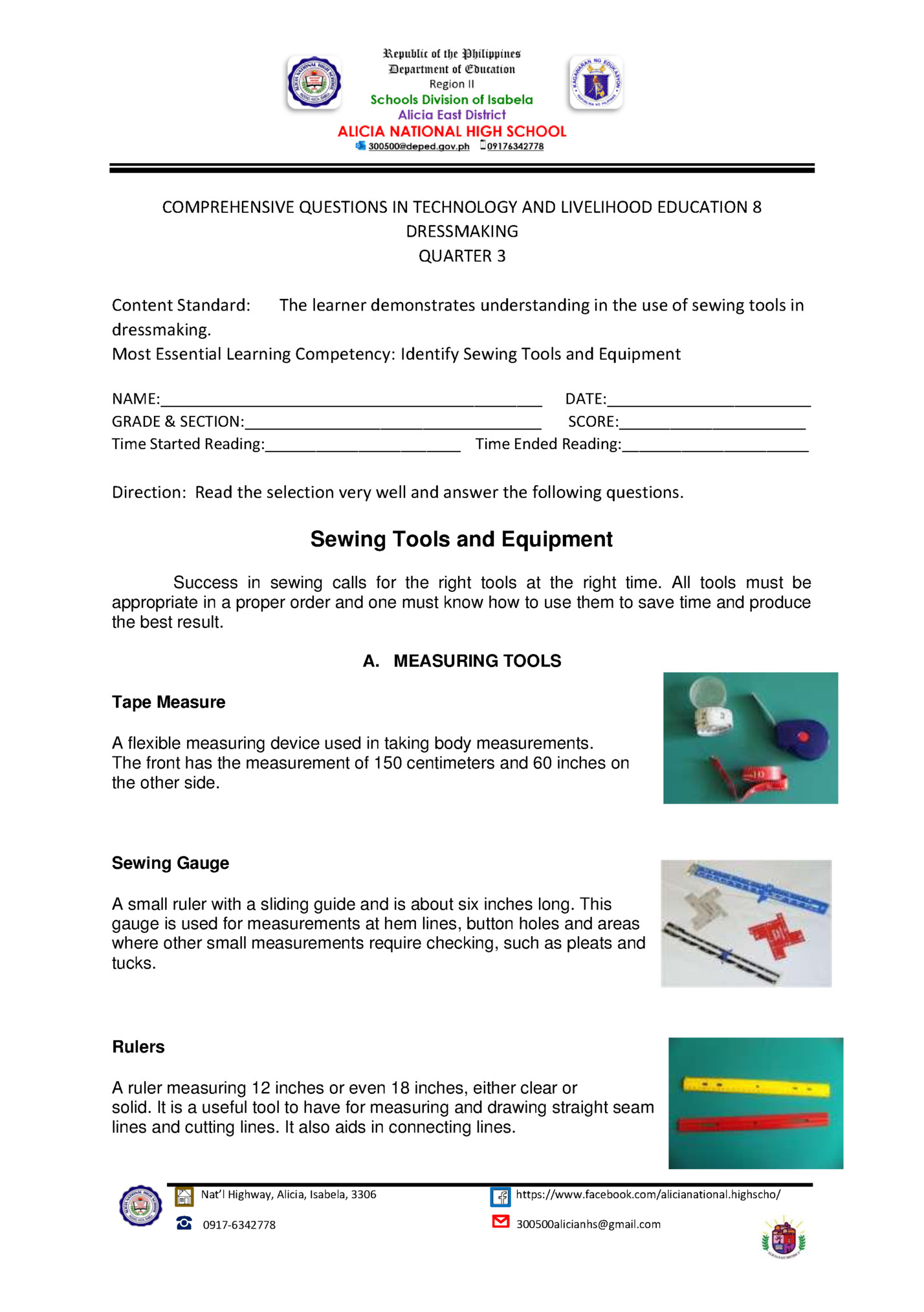
A yardstick is made of smooth, shellacked hardwood or metal. It is used for marking hemlines and checking grainlines when laying out the pattern. L-square The tailor square or "L" is used to transfer measurements to the draft pattern. It also divides the garment into the desired measurement. It has perfect squares and is useful in making straight lines and numbers.. French Curve This is used to shape the depth of the neckhole and armhole of the pattern. B. CUTTING TOOLS Cutting tools are instruments that serve well if properly maintained. Sharp cutting tools make clean cuts and well-defined notches and they do not damage fabric. Sewing cutting tools should not be used for other household task. Cutting tools must be sharpened regularly and the joints are oiled occasionally for better use. Bent-handled dressmaker’s shears These are made of quality steel and hold a sharp cutting edge. Shears have the length of 7- 12 inches and are satisfactory for most apparel fabrics. a. All steels, chrome-plated shears are for heavy duty cutting b. Stainless steel blades and plastic handles are fine for lightweight fabrics c. A serrated edge shears give maximum cutting control and is used for synthetic fibers and slippery knits Pinking Shears This is popular in zigzagging or scalloped edge or for seam finishes. This is used to finish seams and raw edges and to create decorative edges on many types of fabric. Nat’l Highway, Alicia, Isabela, 3306 ☎ 0917-6342778 https://www.facebook.com/alicianational.highscho/ ✉ 300500alicianhs@gmail.com
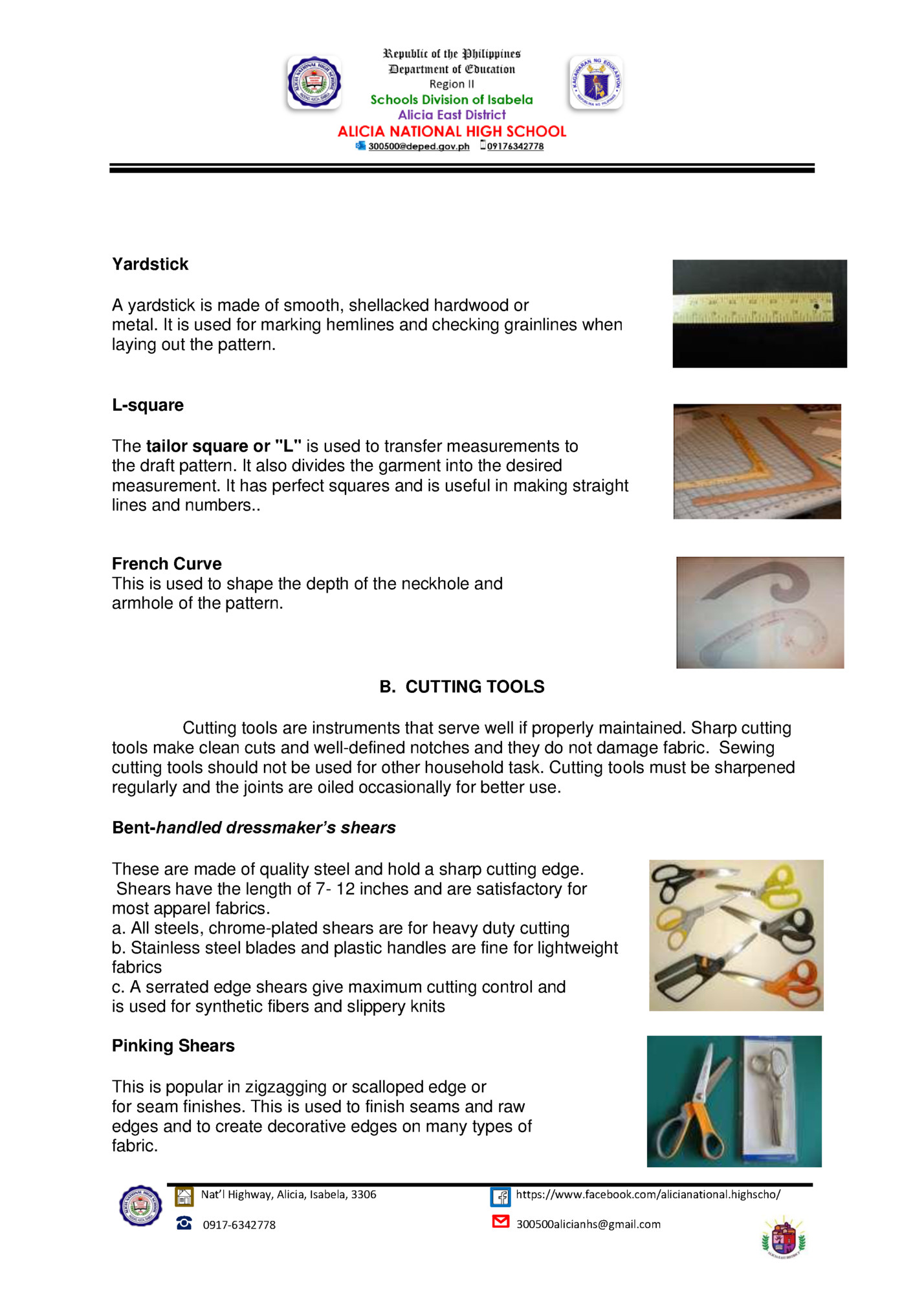
a. Trimming scissor It is 3-4 inches long. It is used for trimmings, clipping threads and snipping slashes. b. Embroidery scissor It has 4-5 inches finely tapered blades. Both points are sharp for use in working with fine details in delicate fabrics and in embroidery work. c. Buttonhole scissor This is intended for making buttonholes. Thread Clippers Thread clippers are a handy little spring loaded cutting tool, specifically used to snip threads and they are not designed to cut fabric. Seam Ripper Seam rippers are specifically designed for ripping out stitches from seams, either as a result of an error or during alterations. Rotary Cutter and Mat It is an adaptation of the giant rotary cutter used by the garment industry. It works like a pizza cutter and can be used by left or right-handed sewers. When using a rotary cutter, work on a cutting mat to protect the blade and the cutting surface. Level: Grade 8 Number of words: 536 Nat’l Highway, Alicia, Isabela, 3306 ☎ 0917-6342778 https://www.facebook.com/alicianational.highscho/ ✉ 300500alicianhs@gmail.com
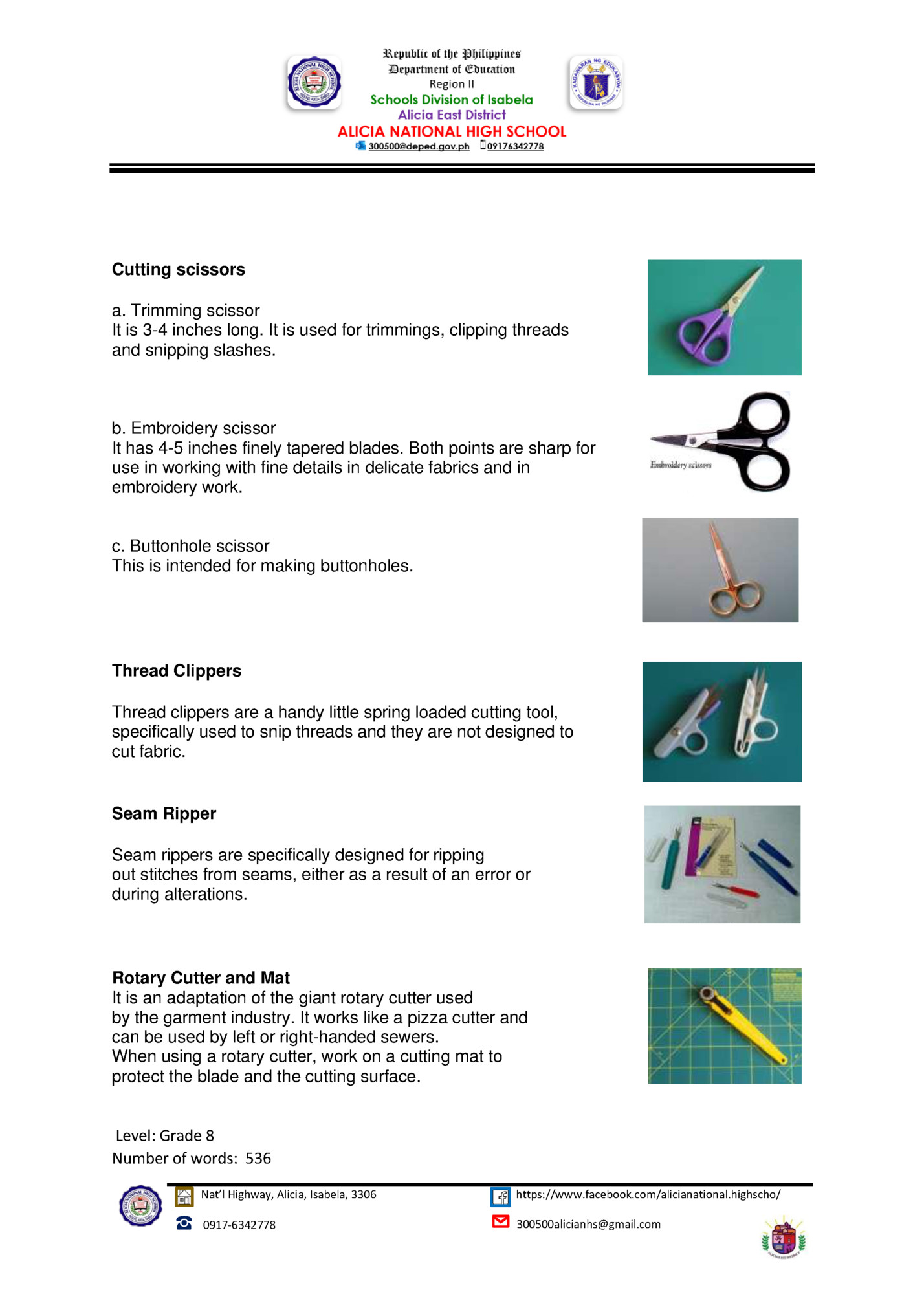
the space provided. ____1. Which of the following is use to measure a fabric? A. C. B. D. ____2. Which among these tools can smoothly cut the entire length and points of a heavy duty and lightweight fabrics satisfactorily? A. Trimming Scissors B. Bent-handled shears C. Rotary Cutter D. Thread Clippers ____3. What measuring tool is appropriate in taking body measurements?Why? A. Tape measure, because it is flexible that follows the figure of body. B. French curve, because it can measure the neckhole of the body. C. Yardstick, because it can measure a fabric with a straight line. D. Ruler, because it can measure the straight portion of the body. ____4. Mang Dress are task to prepare table cloth with decorative zigzagged edges for his client. What cutting tool will he use to bring out the design of the table cloth? A. Pinking Shears * B. Rotary cutter C. Embroidery Scissor D. Thread Clippers ____5. Beauty wants to wear a simple but elegant gown during her 18th birthday. She would like to have a U-shape neckhole design to emphasize her youthful radiant look. What tool the dressmaker will use to measure the depth of her neckline? A. Tape measure B. L-Square C. French Curve * D. Sewing Gauge Prepared by: Checked: MARITES M. JULIAN Teacher I Nat’l Highway, Alicia, Isabela, 3306 ☎ 0917-6342778 ANDRES A. CAPISTRANO TLE Coordinator/MT I https://www.facebook.com/alicianational.highscho/ ✉ 300500alicianhs@gmail.com
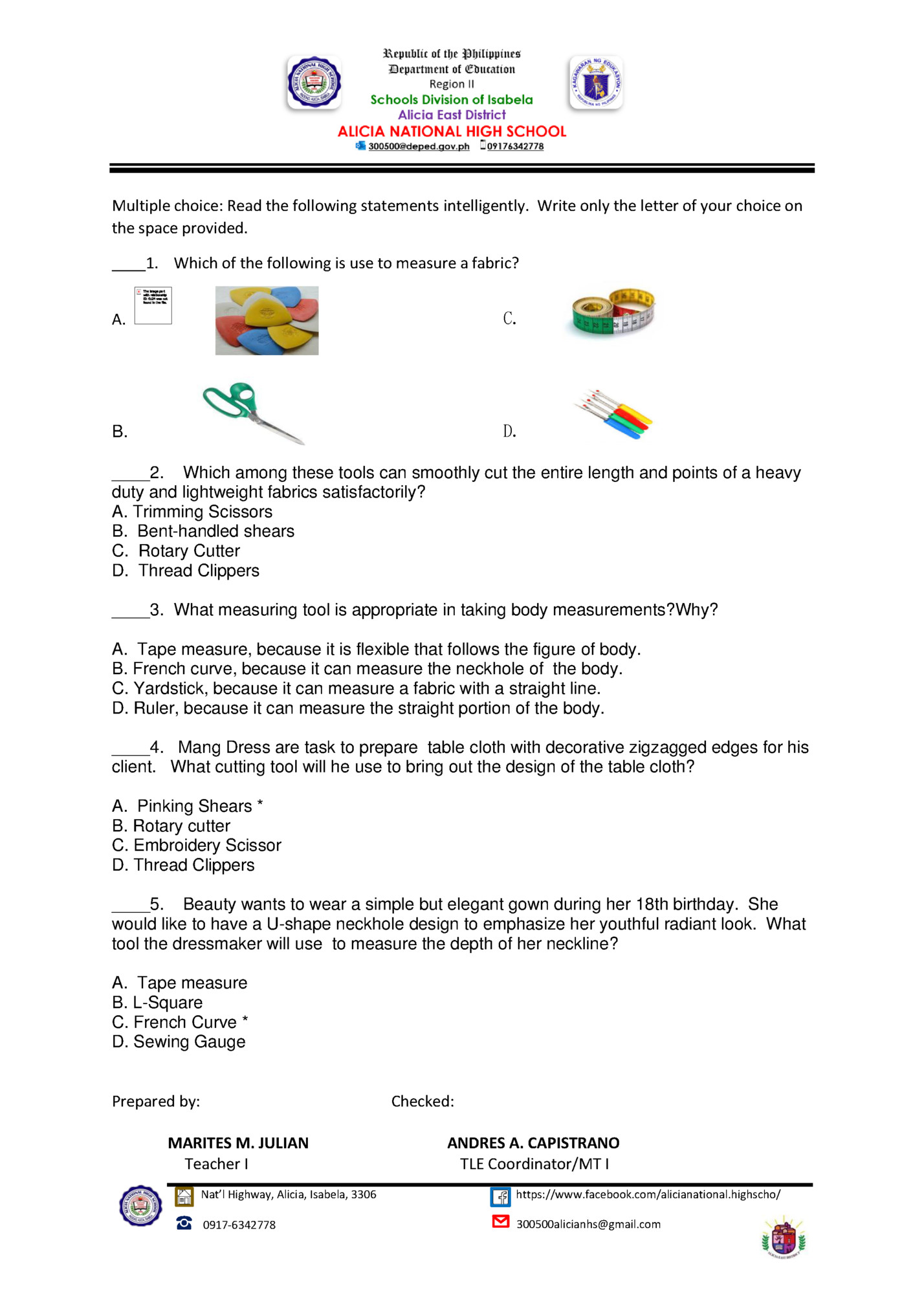
DRESSMAKING QUARTER 3 Content Standard: The learner demonstrates understanding in the use of sewing tools in dressmaking. Most Essential Learning Competency: Classify sewing machines. NAME:_____________________________________________ DATE:________________________ GRADE & SECTION:___________________________________ SCORE:______________________ Time Started Reading:_______________________ Time Ended Reading:______________________ Direction: Read the selection very well and answer the following questions. Types of Sewing Machines Well-selected sewing machine is essential for achieving good results. It should be used correctly in accordance with the job requirements. 1. Lockstitch Sewing Machine. This is usually used in homes and sometimes in school. This is also called ―Domestic Sewing Machine‖. It is run by foot and may also be converted to electric power machine. 2. Hi-Speed Lockstitch Sewing Machine. This is sometimes called straight stitching machine or industrial sewing machine. It has automatic lubrication and is used by tailors and dressmakers. 3. Over Edging Machine. Other companies call it small machine. It finishes the raw edges of the pattern for construction. 4. Embroidery Machine. This is used in making fancy stitches and in making different kinds of embroidery stitches on fabrics for the Barong Tagalog, pillow cases, linen, and other novelty items. Nat’l Highway, Alicia, Isabela, 3306 ☎ 0917-6342778 https://www.facebook.com/alicianational.highscho/ ✉ 300500alicianhs@gmail.com
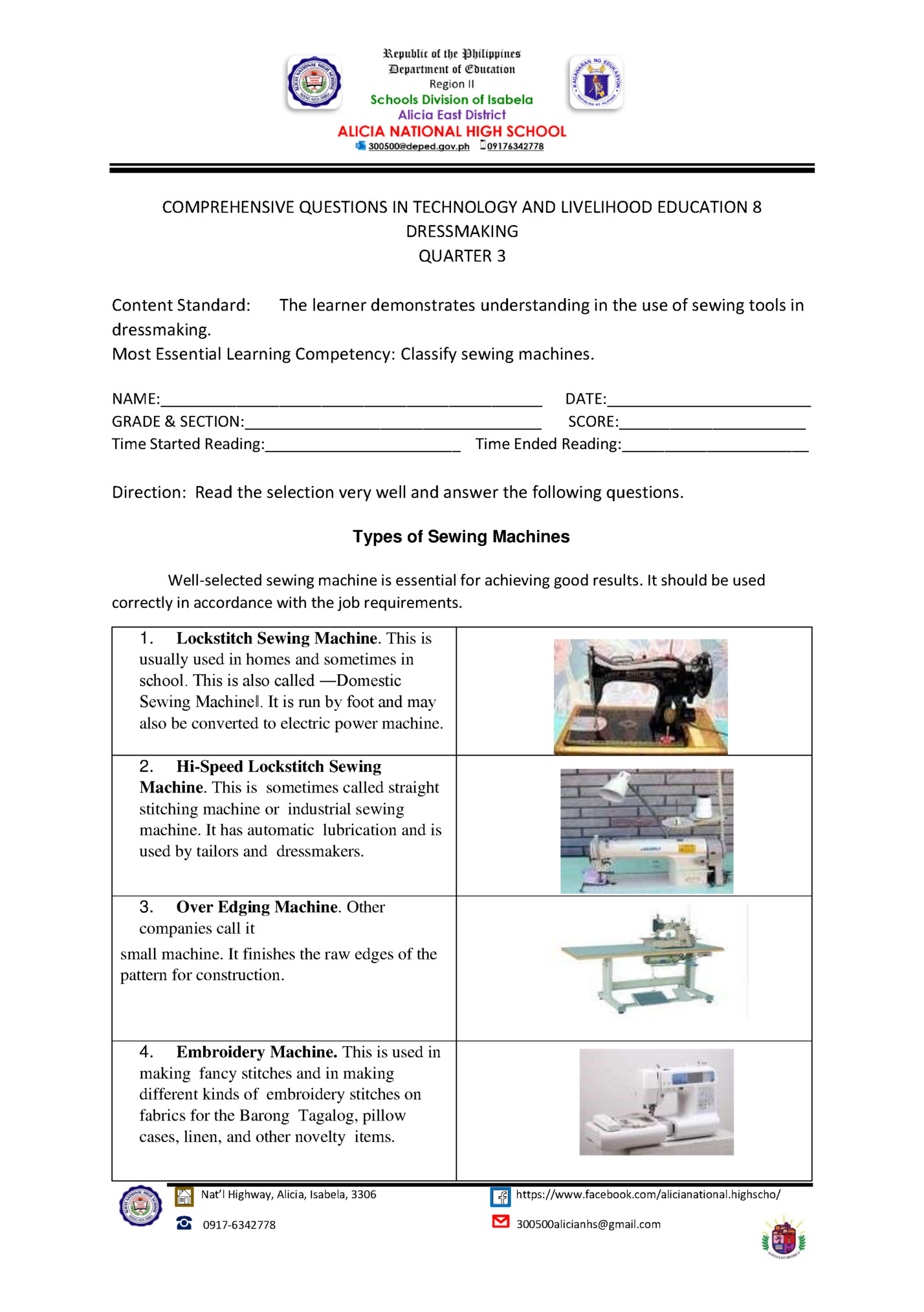
in making buttonholes on garments. 6. Button Attachment Machine. This is used in attaching buttons to the garments. 7. Double Needle Machine. This is used in the construction of the different kinds of clothing especially for the inseam, outseam and side seam. 8. Bartacking Machine. This is used in reinforcing the opening and closing of pockets 9. Knitting Machine - It creates knitted fabrics in a semi or fully automated way. It's most often used to knit flat pieces sewn together to make a garment. The critical parts of a flat bed knitting machine are a needle bed with up to 200 needles and a knit carriage moving from side to side. 10. Quilting Machine- it offers one stitch and one stitch only – the straight stitch. It doesn't have a needle that moves left or right of center and there are no feed dogs. The beauty of a simple quilting machine is its size, its powerful motor and the unique way the quilter moves the machine over the fabric. Level: Grade 8 Nat’l Highway, Alicia, Isabela, 3306 ☎ 0917-6342778 https://www.facebook.com/alicianational.highscho/ ✉ 300500alicianhs@gmail.com

Multiple choice: Read the following statements intelligently. Write only the letter of your choice on the space provided. ___1. Which of the following sewing machine is usually run by foot, and is used by elders? A. Hi-Speed Lockstitch Sewing Machine B. Lockstitch Sewing Machine* C. Bartacking Machine D. Knitting Machine ____2. Which of the following statement gives the proper use of a type of sewing machine? A. Button holer machine is use for inseam and outseam construction. B. Button Attachment Machine is use for pocket construction. C. Quilting Machine straightly use one stitch only.* D. Bartacking Machine is use for fancy stitches. ____3. Which of the following is true about the use of over edging machine? A. It finishes the edges of the pattern.* B. It construct straight stitching. C. It reinforces the pockets. D. It makes button holes. ____4. Andy is preparing for his sons wedding. As a well-known tailor, he wants an embroidered state-of-the-art Barong Tagalog for this special event. What type of sewing machine will the tailor use? A. Button Holer machine B. Embroidery Machine* C. Knitting Machine D. Quilting Machine ____5. Anna wants to surprise her mother who is fond of sewing dress. To make her mother more convenient. She hired a professional mechanic to convert the old machine into an electrical one. Which of the following sewing machine do you think her mother is using? A. Embroidery Machine B. Double Needle Machine C. Lockstitich Sewing Machine* D. Hi-Speed Lockstitch Sewing Machine Prepared by: Checked: MARITES M. JULIAN Teacher I Nat’l Highway, Alicia, Isabela, 3306 ☎ 0917-6342778 ANDRES A. CAPISTRANO TLE Coordinator/MT I https://www.facebook.com/alicianational.highscho/ ✉ 300500alicianhs@gmail.com
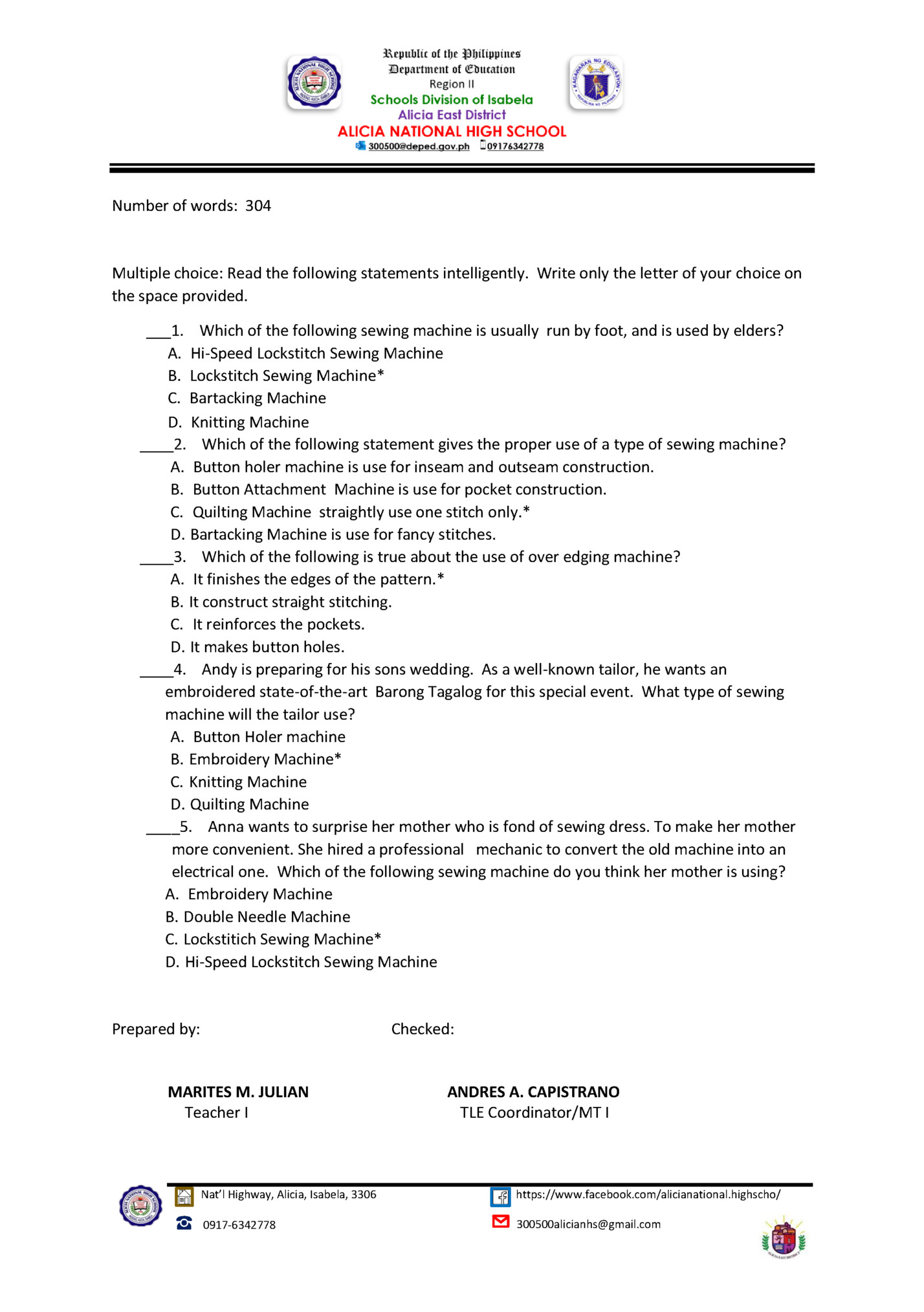
DRESSMAKING QUARTER 3 Content Standard: The learner demonstrates understanding in carrying out measurements in dressmaking/tailoring. Most Essential Learning Competency: Take accurate body measurements NAME:_____________________________________________ DATE:________________________ GRADE & SECTION:___________________________________ SCORE:______________________ Time Started Reading:_______________________ Time Ended Reading:______________________ Direction: Read the selection very well and answer the following questions. OBTAIN MEASUREMENTS Parts of body to be measured can be taken in: ▪ Horizontal measurement ▪ Vertical measurement ▪ Circumferential measurement 1. The horizontal measurement is taken from the left of the figure to the right. 2. 3. The vertical measurement is taken from the top of the body figure to its base. Circumferential measurement is taken around the body. Nat’l Highway, Alicia, Isabela, 3306 ☎ 0917-6342778 https://www.facebook.com/alicianational.highscho/ ✉ 300500alicianhs@gmail.com

Bust - Lift your arms to the side. Measure around your body crossing over the fullest part of your bust. (The tape measure must run directly over your nipples and across your shoulder blades on your back). Bust to Bust - Measure from your one nipple to your other nipple. Upper Bust - Measure around the torso directly above the bust line. From armhole to armhole +- 8cm down from neck. Lower Bust - Measure around the torso directly under the bustline. Waist - Measure around the waist at the narrowest natural waistline point, allowing 2 fingers between your waist and tape measure. Hips - Measure around the fullest part of your hips. As a guide, this is often 20cm below your natural waistline. Stand with your knees together. Shoulder to Bust - Measure from tip of the shoulder to the centre of bust (nipple). Front Shoulder to Waist - Measure from tip of shoulder over bust to natural waistline. Nat’l Highway, Alicia, Isabela, 3306 ☎ 0917-6342778 https://www.facebook.com/alicianational.highscho/ ✉ 300500alicianhs@gmail.com
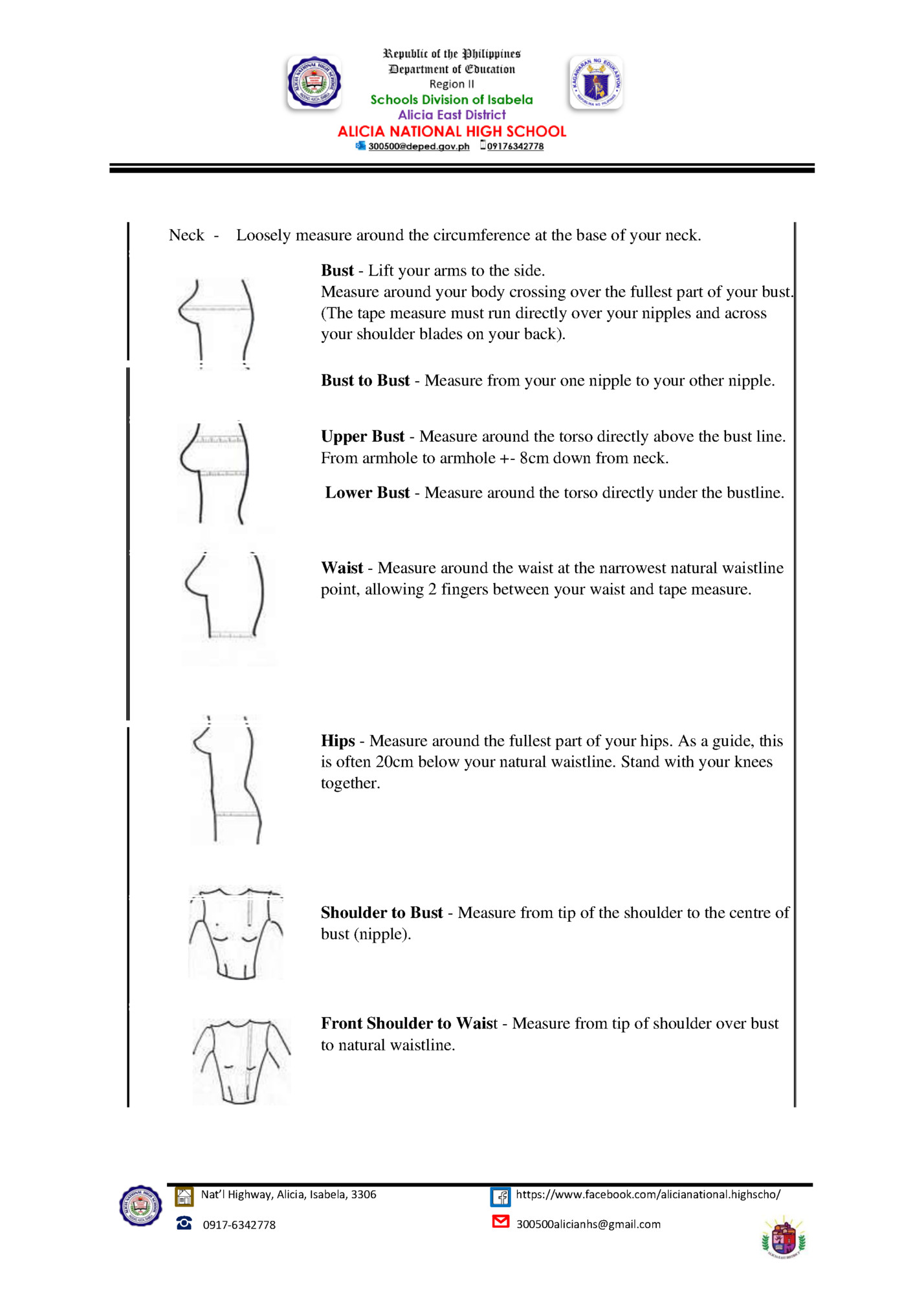
Fleepit Digital © 2021